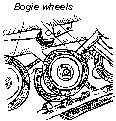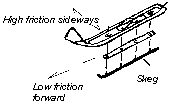Snowmachine Tracks
|
Snowmachines have been in villages long enough that few people
under thirty can remember when dog teams were the main form of transportation.
It wasn’t until science and technology develop good material for a track that snowmachines had a chance of being practical. A book on the Klondike Gold Rush described a powered vehicle that the builder thought could travel over snow. It had a large steel track with big teeth. The first journey of this steam powered vehicle was its last. It dug straight down into the earth, unable to get out. |
||
MaterialA track made of steel is too heavy for the light engines used in snowmachines. Besides, a steel track would become an icy mass as soon as it got into overflow. Natural rubber stretches too much to be good material for a track, and it dissolves in gas and oil. Kevlar provides flexibility, strength, relatively low weight, and durability. The strength of the track is increased by putting nylon cords in the track material. This is like putting steel in concrete. The combination of materials is far stronger than either of the materials separately. The nylon prevents the track from tearing, and the Kevlar keeps the nylon from wearing. Oldtimers understood this same principle. They put beaver fur in spruce gum when they patched a hole in a boat. The beaver fur strengthens the same way the nylon and Kevlar fibers do in the snowmachine track. |
|||
|
|
Choosing a TrackThere are several factors involved in choosing a track: Length A longer machine tends to glide over the tops of the bumps and “floats” more on powder snow. However, if the track is too long it will be hard to steer in tight places and takes more power to turn the track. Short tracks are better for hard trails and sharp corners, as in racing. If the track is too short, the machine will get stuck in soft snow. A short machine tends to give a jerky ride because it goes in and out of all the bumps. Width If the track is too narrow, the machine will be tippy. If it is too wide, it will be hard to steer and require a lot of power to drive it. It will also be too wide for the driver to straddle. Thickness If the track is too thin, it will tear. If it is too thick it will take too much power to drive it, especially in cold weather when everything is stiff. Wise operators elevate the rear of the machine and spin the track for a short time before traveling. This loosens the track and prevents burning the belt on cold starts. Surface The surface of the track is very important. If a track is too smooth, there isn’t enough friction with the surface of the snow, and it will spin out. If the track is too rough, like a machine with racing cleats, it will dig down and get stuck in powder snow. Mountain climbing machines have one- to three-inch paddles on their tracks that allow them to go uphill almost verticle in deep powder snow. Racing machines often have stars bolted on the track surface. They resist spinning out and they don’t slide sideways. Overall Basically, if the track is too large, it takes a lot of power to drive it. If it is too small, the machine sinks in powder snow, or it spins out when pulling a load because there isn’t enough surface area in contact with the snow. There is no perfect track, since one is good for one condition and not good for another. The main things to consider are the surface area, how much flotation and contact are needed, and how much friction is needed. The use of the machine will determine which track to get. |
||

|
SuspensionBogie Wheels The first snowmachines that came to Alaska had bogie wheels inside the track. A snowmachine track is similar to a truck tire. The truck tire is held in shape by air pressure. The snowmachine track is held open by springs, wheels, and rails. Bogie wheel suspension is good because it causes the track to fit the contour of the trail, keeping as much of the track in contact with the trail as possible, increasing the surface area that is exerting friction. However, bogie wheels represent a lot of springs, bearings, and other moving parts that need maintenance. There aren’t many machines left that use them. Most newer machines have slide rails that are held in place by a few strong springs. The track actually slides on the rails that are made from a very low friction material called Hifax, a form of Teflon. Slide rails will wear out rather quickly if there isn’t a little snow lubricating them, particularly on gravel. On a hard trail, a good driver occasionally runs into powder snow to lubricate the slide rails. Without Hifax or some similar low-friction material, slide rails would not be possible. |
||
|
|
|
||
|
|
Belly PlasticIn the effort to make snowmachines more efficient while breaking trail, manufacturers have made sheets of plastic to fit under the belly of the machines to reduce friction. The plastic also provides protection from impact with obstacles. The belly plastic offers that kind of help by reducing friction in powder snow in critical moments. |
||

|
Activities
|
||

|
Student Response
|
||

|
Math
|

 Slide
Rails
Slide
Rails Skis
Skis